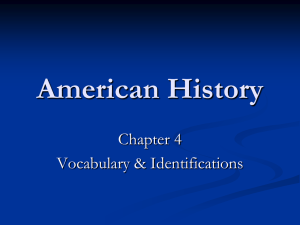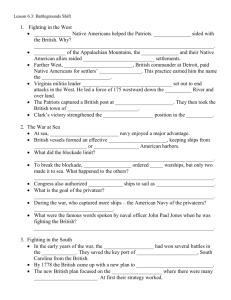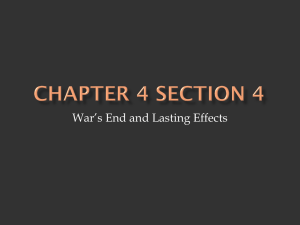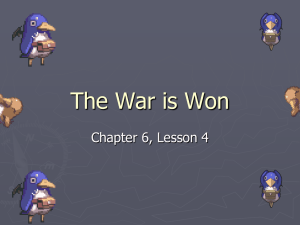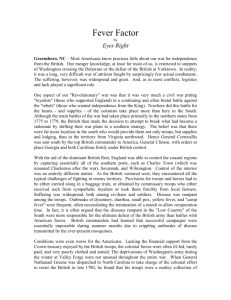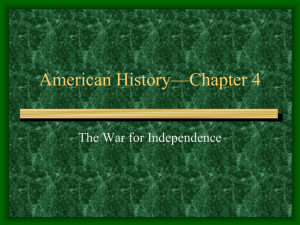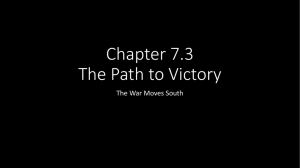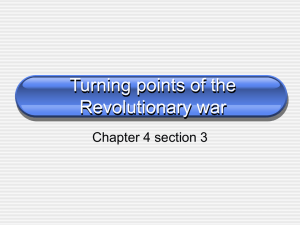PrepUS History Unit 2 - The American Revolution
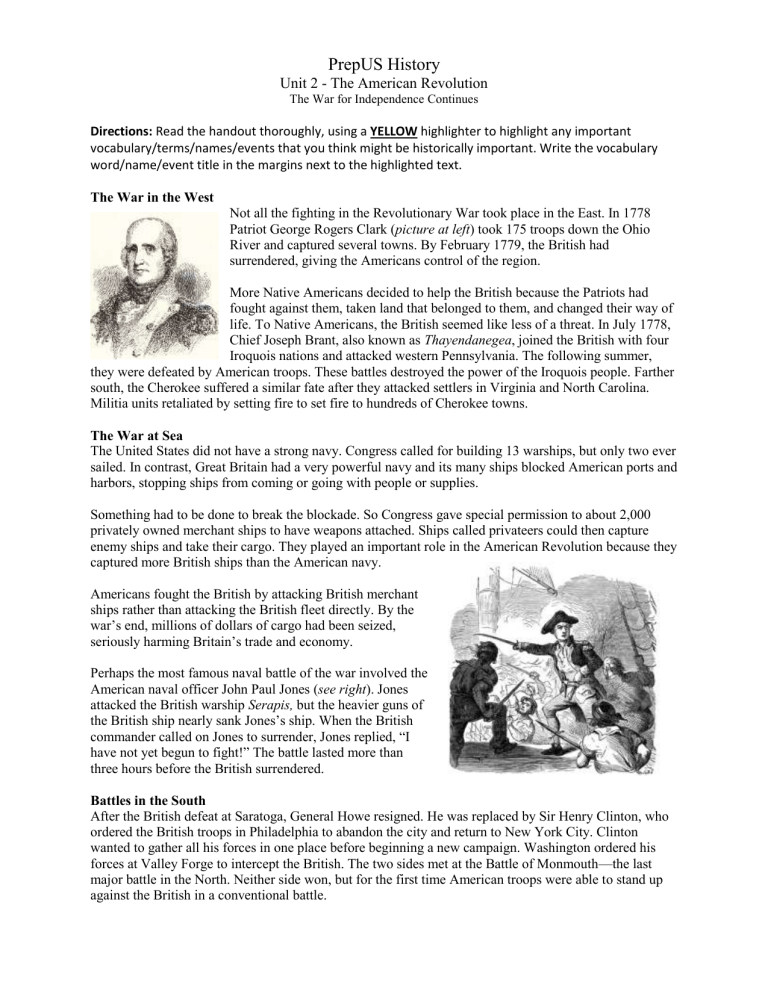
PrepUS History
Unit 2 - The American Revolution
The War for Independence Continues
Directions: Read the handout thoroughly, using a YELLOW highlighter to highlight any important vocabulary/terms/names/events that you think might be historically important. Write the vocabulary word/name/event title in the margins next to the highlighted text.
The War in the West
Not all the fighting in the Revolutionary War took place in the East. In 1778
Patriot George Rogers Clark ( picture at left ) took 175 troops down the Ohio
River and captured several towns. By February 1779, the British had surrendered, giving the Americans control of the region.
More Native Americans decided to help the British because the Patriots had fought against them, taken land that belonged to them, and changed their way of life. To Native Americans, the British seemed like less of a threat. In July 1778,
Chief Joseph Brant, also known as Thayendanegea , joined the British with four
Iroquois nations and attacked western Pennsylvania. The following summer, they were defeated by American troops. These battles destroyed the power of the Iroquois people. Farther south, the Cherokee suffered a similar fate after they attacked settlers in Virginia and North Carolina.
Militia units retaliated by setting fire to set fire to hundreds of Cherokee towns.
The War at Sea
The United States did not have a strong navy. Congress called for building 13 warships, but only two ever sailed. In contrast, Great Britain had a very powerful navy and its many ships blocked American ports and harbors, stopping ships from coming or going with people or supplies.
Something had to be done to break the blockade. So Congress gave special permission to about 2,000 privately owned merchant ships to have weapons attached. Ships called privateers could then capture enemy ships and take their cargo. They played an important role in the American Revolution because they captured more British ships than the American navy.
Americans fought the British by attacking British merchant ships rather than attacking the British fleet directly. By the war’s end, millions of dollars of cargo had been seized, seriously harming Britain’s trade and economy.
Perhaps the most famous naval battle of the war involved the
American naval officer John Paul Jones ( see right ). Jones attacked the British warship Serapis, but the heavier guns of the British ship nearly sank Jones’s ship. When the British commander called on Jones to surrender, Jones replied, “I have not yet begun to fight!” The battle lasted more than three hours before the British surrendered.
Battles in the South
After the British defeat at Saratoga, General Howe resigned. He was replaced by Sir Henry Clinton, who ordered the British troops in Philadelphia to abandon the city and return to New York City. Clinton wanted to gather all his forces in one place before beginning a new campaign. Washington ordered his forces at Valley Forge to intercept the British. The two sides met at the Battle of Monmouth—the last major battle in the North. Neither side won, but for the first time American troops were able to stand up against the British in a conventional battle.
After Clinton reached New York, he began a campaign in the South, where the British had the strongest
Loyalist support. The British believed they could use strong Loyalist support and their naval power to help them win the South. The British did not get the Loyalist support they hoped for. They also had to deal with American hit-and-run tactics. Patriot forces would attack the British by surprise, and then disappear again. Francis Marion, called the “Swamp Fox,” ( see above ) was a successful Patriot leader in the South. He was quick and smart, and he hid from the British easily in the eastern South Carolina swamps.
The Struggle in the Carolinas
In December 1778, some 3,500 British troops captured Savannah, Georgia. They seized control of
Georgia’s backcountry and returned the British royal governor to power. The next objective was to capture Charles Town, South Carolina—the largest city in the South. Clinton attacked Charles Town, his forces quickly surrounding the city, trapping the American forces inside. On May 12, 1780, the
Americans surrendered. About 5,500 Americans were taken prisoner, the greatest American defeat in the war.
After capturing Charles Town, Clinton returned to New York, leaving General Charles Cornwallis in command. The Continental Congress then sent General Horatio Gates to defend the South Carolina backcountry. His attempt to destroy a British supply base at Camden, South Carolina, failed.
The Battle of Kings Mountain
After the Battle of Camden, the British began subduing the Carolina backcountry. Two British cavalry officers, Banastre Tarleton and Patrick Ferguson, led many of the Loyalist forces in the region. These troops became known for their brutality. Enraged at Ferguson’s tactics, the “overmountain” men, as they were known, put together a militia. They intercepted Ferguson at Kings Mountain on October 7, 1780, and destroyed his army. By late 1781, the British controlled very little of the South.
The Battle of Yorktown
In the spring of 1781, Cornwallis marched into Virginia. There he joined forces with Benedict Arnold, a former American general who had changed sides to fight for the British. The British gave him command of British troops and ordered him to Virginia.
After Arnold joined Cornwallis, the British began to conquer
Virginia. Then, a large American force led by General Anthony
Wayne arrived. Outnumbered and too far inland, Cornwallis retreated to the coastal town of Yorktown to protect his supplies and to maintain communications by sea.
Cornwallis’s retreat created an opportunity. Washington decided to march on New York City with 6,000
French troops. As the troops headed to New York, Washington learned that Admiral de Grasse and his
2
French fleet were sailing north from the Caribbean to the Chesapeake Bay. Washington canceled the attack on New York City. Instead, he and the French general Rochambeau headed to Yorktown.
Rochambeau’s fleet cut off the flow of supplies to Cornwallis and prevented him from escaping by sea.
On September 28, 1781, American and French forces surrounded Yorktown and began to bombard it. On
October 14, Washington’s aide, Alexander Hamilton, led an attack that captured key British defenses.
Three days later, Cornwallis began negotiations to surrender, and on October 19, 1781, some 8,000
British soldiers laid down their weapons.
The Treaty of Paris
In March 1782, Parliament voted to begin peace negotiations. John Adams, Benjamin Franklin, and John
Jay conducted most of the negotiations for the United States. On September 3, 1783, three treaties were signed—between Britain and the United States and between Britain and France and Spain.
In the final settlement, known as the Treaty of Paris, Britain recognized the United States of America as an independent nation, with the Mississippi River as its western border. Britain gave Florida back to
Spain, and France received colonies in Africa and the Caribbean. On November 24, 1783, the last British troops left New York City. The American Revolution was over. A new nation was born.
NOW - go back through the reading and use a DIFFERENT COLORED highlighter to highlight the portion of the text that answers each of questions below, marking the text with the question number. If you already highlighted the text that answers a question in yellow, just write the question number in the margin next to it (you do not need to highlight it again in the other color).
1. Why did more Native Americans side with the British than with the Patriots?
4.
5.
2.
3.
Who was Joseph Brant?
What is a blockade? What did Americans do to combat the blockade?
What is a privateer?
Who was John Paul Jones? What did he do?
6.
7.
Why was the Battle of Monmouth important for the Patriots?
What special method of fighting did Francis Marion use in his attacks on the British?
8. Why did Patriot forces particularly dislike Banastre Tarleton and Patrick Ferguson?
9. What tactics did the Patriots use to defeat the British at the Battle of Yorktown?
10. What did the Patriots “win” from the American Revolution?
3
